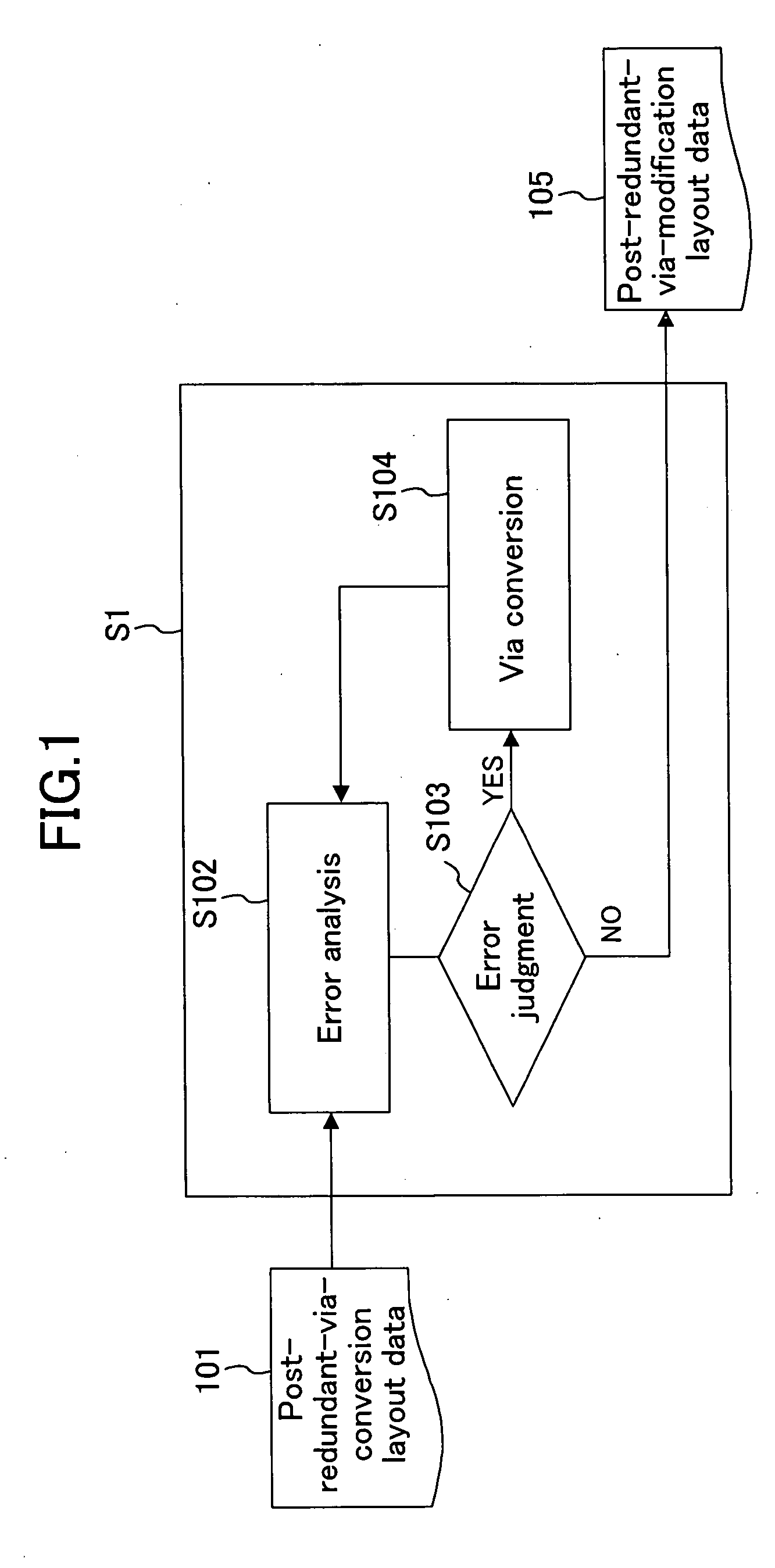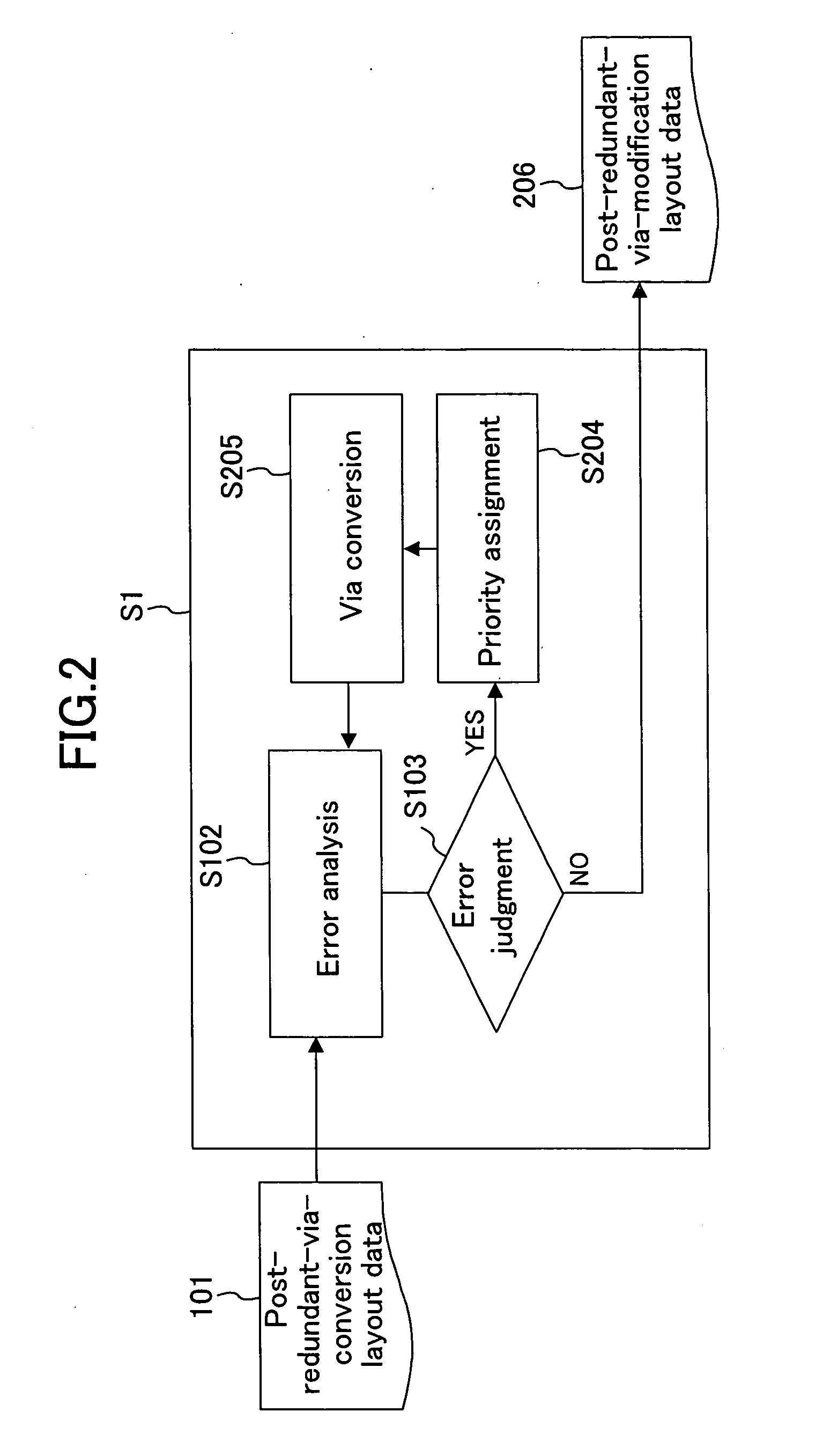Design method of semiconductor device and semiconductor device
a design method and semiconductor technology, applied in the direction of software simulation/interpretation/emulation, instruments, program control, etc., can solve the problems of reduced yield, insufficient redundant via conversion, and difficulty in achieving a miniaturized design pattern with high accuracy, so as to reduce the incidence of electromigration and improve the effect of efficiency
- Summary
- Abstract
- Description
- Claims
- Application Information
AI Technical Summary
Benefits of technology
Problems solved by technology
Method used
Image
Examples
first embodiment
[0046] Hereinafter, a first embodiment of the present invention will be described with reference to the accompanying drawings.
[0047]FIG. 1 is a diagram illustrating process steps performed by computer using a method for designing a semiconductor device according to the first embodiment of the present invention.
[0048] In FIG. 1, the reference numeral 101 denotes post-redundant-via-conversion layout data. Step S102 is the error analysis step of performing an error analysis for the post-redundant-via-conversion layout data 101 which has been input. Step S103 is the error judgment step of judging whether or not an error exists in a result of an error analysis of Step S102. Step S104 is the via conversion step of reconverting a redundant via to a single via when an error is found in the Step S103. The reference numeral 105 denotes layout data which is obtained after redundant via conversion and is to be output from the error judgment step S103 when an error is not found in the Step S10...
second embodiment
[0060] Hereinafter, a second embodiment of the present invention will be described with reference to the accompanying drawings.
[0061]FIG. 2 is a diagram illustrating process steps using a method for designing a semiconductor device according to the second embodiment of the present invention.
[0062] In FIG. 2 illustrating this embodiment, as in FIG. 1 shown in the first embodiment, an error analysis for a timing constraint violation, an antenna effect error or the like is performed to post-redundant-via-conversion layout data 101 in the error analysis step S102 of the computer processing step 1 and an error judgment is performed for a result of the analysis in the error judgment step (judgment step) S103.
[0063] This embodiment is different from the first embodiment in that the priority assigning step (redundant via priority determination step) S204 of assigning priorities to errors such as an antenna effect error and a timing constraint violation caused by redundant vias being prov...
third embodiment
[0077] Hereinafter, a third embodiment of the present invention will be described with reference to the accompanying drawings.
[0078]FIG. 5 is a diagram illustrating process steps using a method for designing a semiconductor device according to the third embodiment of the present invention.
[0079] In FIG. 5, the reference numeral 501 denotes post-detail-routing layout data, Step S502 denotes the priority assigning step of assigning priorities in layout data after detail routing which has been input with respect to conversion of a single via to a redundant via, Step S503 denotes the via conversion step of converting a single via to a redundant via based on a result of priority assignment in the priority assigning step S502, and the reference numeral 504 denotes the post-redundant-via-conversion layout data output after conversion of a single via to a redundant via in the via conversion step S503. Among the above-described steps, the redundant via conversion step S505 including the pr...
PUM
 Login to View More
Login to View More Abstract
Description
Claims
Application Information
 Login to View More
Login to View More - R&D
- Intellectual Property
- Life Sciences
- Materials
- Tech Scout
- Unparalleled Data Quality
- Higher Quality Content
- 60% Fewer Hallucinations
Browse by: Latest US Patents, China's latest patents, Technical Efficacy Thesaurus, Application Domain, Technology Topic, Popular Technical Reports.
© 2025 PatSnap. All rights reserved.Legal|Privacy policy|Modern Slavery Act Transparency Statement|Sitemap|About US| Contact US: help@patsnap.com



